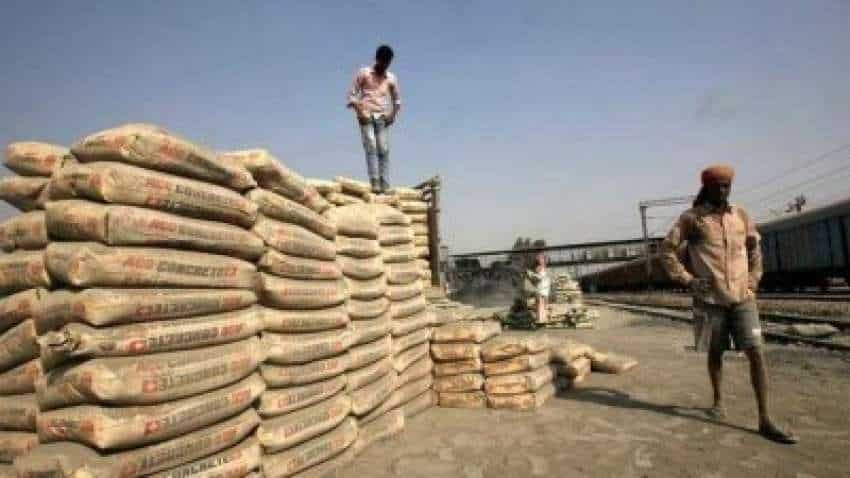Cement sector battling a cost wave? 4 triggers that may aid industry for further growth
The higher commodity prices, rising input cost and shortage of raw materials are impacting the overall cement sector, amid this CARE Ratings highlights the issues and solutions in the sector.

As the demand picks up across the sectors, the cement industry is battling with a cost wave in the recent past. The higher commodity prices, rising input cost and shortage of raw materials are impacting the overall cement sector, amid this CARE Ratings highlights the issues and solutions in the sector.
For the month ending September 2021, key cost constituents, which are pet coke, international coal and diesel, are up 20, 111, and 21 per cent, respectively from the March 2021 levels, says the report.
See Zee Business Live TV Streaming Below:
Besides power, the sectors such as metal, fertilizers, textile, chemical and cement have also faced a scarcity of coal. However, the supply of coal had been lately stopped to other sectors except for power amid electricity outage issue amid lower production of coal.
On the other hand, the cement companies also incur high transport and logistics cost in both manufacturing as well as distribution process. Procurement and inward movement of raw materials like coal, transportation of clinker, distribution of cement to the markets entail high logistics cost.
The sector shall also benefit from the pent-up demand due to the halt of all new projects during the Covid era. CARE Ratings expects the overall cement production to reach the pre-covid levels by registering a robust mid-term growth in FY22 over a low base of FY21.
Triggers and things to watch out for
Demand: Higher government spending on infrastructure and low-cost housing and a favourable-base effect as well as the government’s focus on the upcoming elections would spur demand of cement in coming years.
Capacity utilisation: Utilisation to rise again in the medium term from FY21 levels on the back of improving demand outlook but as new planned capacities of around 100-110 million tonnes gets commissioned over FY22– FY25E, it is likely to affect utilisation levels to some extent.
Realisations: The cement prices are expected to largely remain sustained at higher levels, driven by demand drivers, increased consolidation in the industry and the higher input costs which would necessitate passing on of the elevated costs to some extent.
Costs: As the costs head northwards, the higher input costs and freight costs are likely to affect the margins of cement players but healthy realisations on the back of strong demand likely to limit margin contraction.
Get Latest Business News, Stock Market Updates and Videos; Check your tax outgo through Income Tax Calculator and save money through our Personal Finance coverage. Check Business Breaking News Live on Zee Business Twitter and Facebook. Subscribe on YouTube.
RECOMMENDED STORIES

Power of Compounding: How soon will monthly SIP of Rs 6,000, Rs 8,000, and Rs 10,000 reach Rs 5 crore corpus target?

SBI Guaranteed Return Scheme: Know how much maturity amount you will get on Rs 2 lakh, 2.5 lakh, 3 lakh, 3.5 lakh and Rs 4 lakh investments under Amrit Vrishti FD scheme

SBI Senior Citizen FD Rate: Here's what State Bank of India giving on 1-year, 3-year, 5-year fixed deposits currently

SBI Senior Citizen Latest FD Rates: What senior citizens can get on Rs 7 lakh, Rs 14 lakh, and Rs 21 lakh investments in Amrit Vrishti, 1-, 3-, and 5-year fixed deposits
05:19 PM IST









 Supreme Court ruling on royalties, taxes to affect mining firms' profitability: Moody's
Supreme Court ruling on royalties, taxes to affect mining firms' profitability: Moody's  Cement sector Q4 preview: Volume likely to grow in high single-digits; impact of weak cement prices to be offset by lower costs, operating leverage
Cement sector Q4 preview: Volume likely to grow in high single-digits; impact of weak cement prices to be offset by lower costs, operating leverage Cement sector Q3 preview: EBITDA likely to improve amid low double-digit demand growth
Cement sector Q3 preview: EBITDA likely to improve amid low double-digit demand growth Cement sector Q1 review: What lies ahead after mixed performance in Q1? Check top stocks to bet on
Cement sector Q1 review: What lies ahead after mixed performance in Q1? Check top stocks to bet on Cement companies likely to invest Rs 1.2 lakh crore to add 145-155 metric tonnes capacity by FY27
Cement companies likely to invest Rs 1.2 lakh crore to add 145-155 metric tonnes capacity by FY27